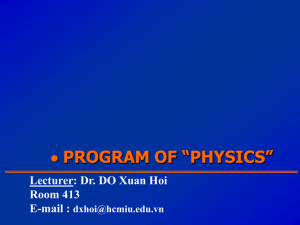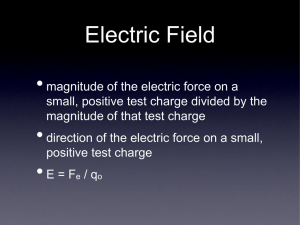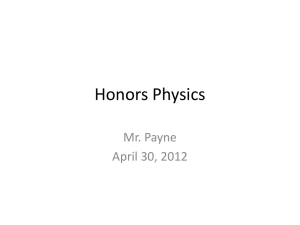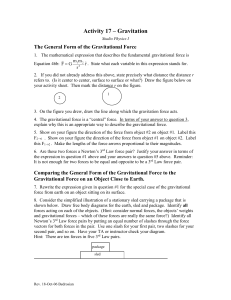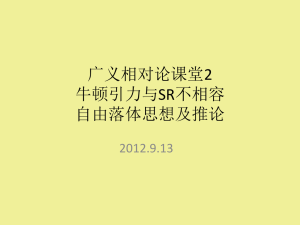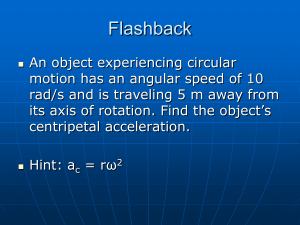307_Wk10
advertisement
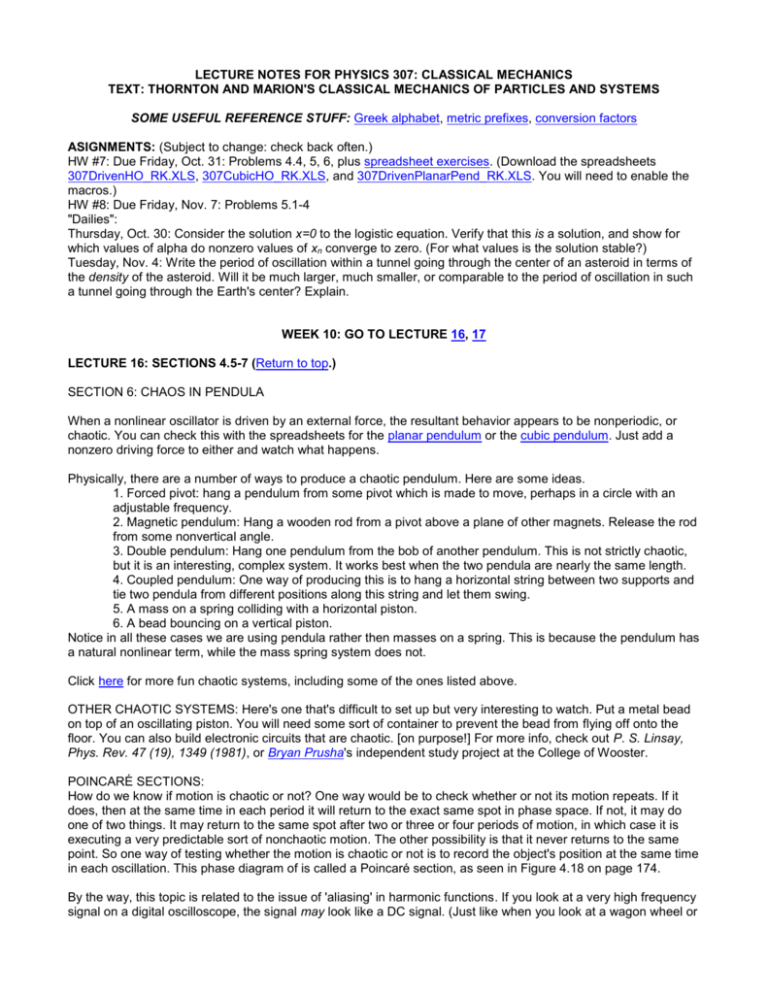
LECTURE NOTES FOR PHYSICS 307: CLASSICAL MECHANICS TEXT: THORNTON AND MARION'S CLASSICAL MECHANICS OF PARTICLES AND SYSTEMS SOME USEFUL REFERENCE STUFF: Greek alphabet, metric prefixes, conversion factors ASIGNMENTS: (Subject to change: check back often.) HW #7: Due Friday, Oct. 31: Problems 4.4, 5, 6, plus spreadsheet exercises. (Download the spreadsheets 307DrivenHO_RK.XLS, 307CubicHO_RK.XLS, and 307DrivenPlanarPend_RK.XLS. You will need to enable the macros.) HW #8: Due Friday, Nov. 7: Problems 5.1-4 "Dailies": Thursday, Oct. 30: Consider the solution x=0 to the logistic equation. Verify that this is a solution, and show for which values of alpha do nonzero values of xn converge to zero. (For what values is the solution stable?) Tuesday, Nov. 4: Write the period of oscillation within a tunnel going through the center of an asteroid in terms of the density of the asteroid. Will it be much larger, much smaller, or comparable to the period of oscillation in such a tunnel going through the Earth's center? Explain. WEEK 10: GO TO LECTURE 16, 17 LECTURE 16: SECTIONS 4.5-7 (Return to top.) SECTION 6: CHAOS IN PENDULA When a nonlinear oscillator is driven by an external force, the resultant behavior appears to be nonperiodic, or chaotic. You can check this with the spreadsheets for the planar pendulum or the cubic pendulum. Just add a nonzero driving force to either and watch what happens. Physically, there are a number of ways to produce a chaotic pendulum. Here are some ideas. 1. Forced pivot: hang a pendulum from some pivot which is made to move, perhaps in a circle with an adjustable frequency. 2. Magnetic pendulum: Hang a wooden rod from a pivot above a plane of other magnets. Release the rod from some nonvertical angle. 3. Double pendulum: Hang one pendulum from the bob of another pendulum. This is not strictly chaotic, but it is an interesting, complex system. It works best when the two pendula are nearly the same length. 4. Coupled pendulum: One way of producing this is to hang a horizontal string between two supports and tie two pendula from different positions along this string and let them swing. 5. A mass on a spring colliding with a horizontal piston. 6. A bead bouncing on a vertical piston. Notice in all these cases we are using pendula rather then masses on a spring. This is because the pendulum has a natural nonlinear term, while the mass spring system does not. Click here for more fun chaotic systems, including some of the ones listed above. OTHER CHAOTIC SYSTEMS: Here's one that's difficult to set up but very interesting to watch. Put a metal bead on top of an oscillating piston. You will need some sort of container to prevent the bead from flying off onto the floor. You can also build electronic circuits that are chaotic. [on purpose!] For more info, check out P. S. Linsay, Phys. Rev. 47 (19), 1349 (1981), or Bryan Prusha's independent study project at the College of Wooster. POINCARÉ SECTIONS: How do we know if motion is chaotic or not? One way would be to check whether or not its motion repeats. If it does, then at the same time in each period it will return to the exact same spot in phase space. If not, it may do one of two things. It may return to the same spot after two or three or four periods of motion, in which case it is executing a very predictable sort of nonchaotic motion. The other possibility is that it never returns to the same point. So one way of testing whether the motion is chaotic or not is to record the object's position at the same time in each oscillation. This phase diagram of is called a Poincaré section, as seen in Figure 4.18 on page 174. By the way, this topic is related to the issue of 'aliasing' in harmonic functions. If you look at a very high frequency signal on a digital oscilloscope, the signal may look like a DC signal. (Just like when you look at a wagon wheel or car tire in a movie, it may appear to be rotating in the wrong direction.) We'll discuss this in class, and how it relates to Poincaré. Click here for some cool stuff from a Davidson physics major. THE LOGISTIC EQUATION AND MAPPINGS (See also Chaos Hypertextbook) Often in physics one comes across transcendental equations in which the answer you are solving for on the left side of the equation appears on the right hand side of the equation as well. In other words, you have to know the answer in order to solve for the answer. (A good example is Eq. 2.45 on page 66 of the text, a projectile motion with drag problem.) One way to solve these is to plug in an estimate of the answer on the righthand side to solve for the lefthand side. Obviously, you need to repeat this again and again to approach the right answer. This is called an iterative technique. We can study the relation between successive answers for a particular problem. We will call this a mapping when we collect pairs of successive iterative solutions. It would be useful to know when such a procedure works and when it does not. Equation 4.45, the "logistic equation" is a wonderful illustration of such iterative technique. If we set α equal to a number between 1 and 3, as the book does, we find that initial guesses lead us to converge on a final value for which xn+1=xn. However, for α greater than 3, all hell breaks loose. Instead of converging on a single final value, the iteration converges on two different values that alternate. So, we now have xn+2=xn, but not xn+1=xn. If we plot the limit of xn as n approaches infinity as a function of α, the curve bifurcates at α. Fact is, it bifurcates again, giving four values, then eight, then 16. This is called period doubling and it happens for a lot of actual physical systems, including a dripping faucet. Eventually, after an infinite number of doublings, the resultant sequence of xn's appears chaotic. Now, returning to the logistic equation, it is possible to rearrange the equation to solve for the solutions to xn+1=xn in a way that they do converge. We can also analyze the stability of the solutions to that equation by seeing what happens if we add a small number, ε, to the solution. We'll do this in class, and there are some homework problems (Problem 4.5) in which we'll try to 'save' iterative techniques that diverge rather than converge. These kinds of examples, and the logistic equation itself, lend themselves well to the use of spreadsheets to solve them. LYUPANOV EXPONENTS Skip this. LECTURE 17: SECTIONS 5.1-4 (Return to top.) THE UNIVERSAL LAW OF GRAVITATION We will begin our discussion of gravity with the "Force approach", namely with an equation for the force between two masses. Consider the force on a mass, m, due to some other mass, M: GMm F 2 eˆ R r where G = 6.67 x 10-11 N m2/kg2, the universal constant of gravitation, and ê R is a unit vector pointing from the "source mass" M to the mass which is experiencing the force. This expression is also known as Cavendish's equation. Thanks to Newton's Third Law, this force is equal and opposite to the force acting on M due to m. The more general general expression for the force on m occurs when that mass is near a distribution of mass having a mass density r. In that case, r d F Gm eˆ R r2 where d is an increment of volume. Notice: the integration is over primed coordinates. Beware: r is the distance between the point mass, m and the charge increment r d . In other words, r changes as you do the integration. Ouch. Not a pretty integral to do in practice. PRINCIPAL QUANTITIES OF GRAVITATION Because this is an inverse square law, this force is an awful lot like the electrostatic force. The principal difference, aside from all of the differences in variable names, is that there is only one "flavor of charge" for gravitation. That is, all objects with mass attract, unlike electric charges, which will either attract or repel depending on which "flavor" each charge has (like or unlike). We can develop the mathematics of the gravitational field by using this analogy with electric fields. And so we can define the gravitational field vector, F g , m analogous to the electric field vector, E. We can use the "Energy Approach" to define another quantity which describe this "gravitational field". First of all, we can calculate the gravitational potential energy by integrating the expression for force above. Next, we define the gravitational potential at a positionss in space by dividing this potential energy of an object at that point in space by its mass. For two point masses, this gravitational potential equals U GM m r where r is the distance of our mass them from the mass, M, which is creating this field. If the gravitational potential is created by a collection of charges or by a distribution of charge, then we can rewrite this gravitational potential as G r d r Okay, one final analogy with electrostatics. There is a form of Gauss' law which allows us a shortcut for solving for the gravitational field for some simple problems. For such problems, g da 4 GM enclosed This integral equation is equivalent to two vector calculus equations: g 4 G and 2 4 G In conclusion, we can picture the gravitational field as being characterized by any one of three variables: r , F , and g. Knowing any one of these three variables, we can solve for the other two. I'll provide you with a diagram for visualizing this in class. LINES OF GRAVITATIONAL FIELD AND EQUIPOTENTIAL SURFACES The lines of gravitational field and the equipotential surfaces are very similar to what you've already seen for their electrostatic equivalents. You might want to peek at my E&M notes to compare. Also check out this animation orginally designed for displaying electric field lines. Be sure to use "charges" of the same sign if you wish to simulate the lines of gravitational force. APPLYING THE "GRAVITATIONAL GAUSSIAN EQUATION" The book doesn't do anything with the gravitational equivalent of Gauss' law I gave you above. I will, but first I should give you some ideas about how to approach problems involving this integral equation. The most important thing is to use a convenient Gaussian surface. How do you do that? 1. Sketch the field lines in this problem, using what you know about the symmetry of the problem. 2. Choose surfaces either parallel to or perpendicular to the gravitational field lines. We'll do some of the most basic problems: a point mass (0D), a line of constant linear mass density (1D), a plane or spherical shell (2D), inside a region of constant mass [per volume] density, just to remind you how to do Gaussian surface problems. The cool thing is that, if we consider a person falling through a hole through the center of the Earth, we find that she will oscillate about the center with simple harmonic motion. Likewise, if we drill a tunnel to Potsdam, and can eliminate friction with the sides of the tunnel, you would oscillate in this tunnel with the exact same period as in your tunnel to Australia. Neat, huh? Expect me to show this in class. Plus, please check out the following SF story on such a tunnel. YSBATs Return to syllabus Return to Koon’s homepage



